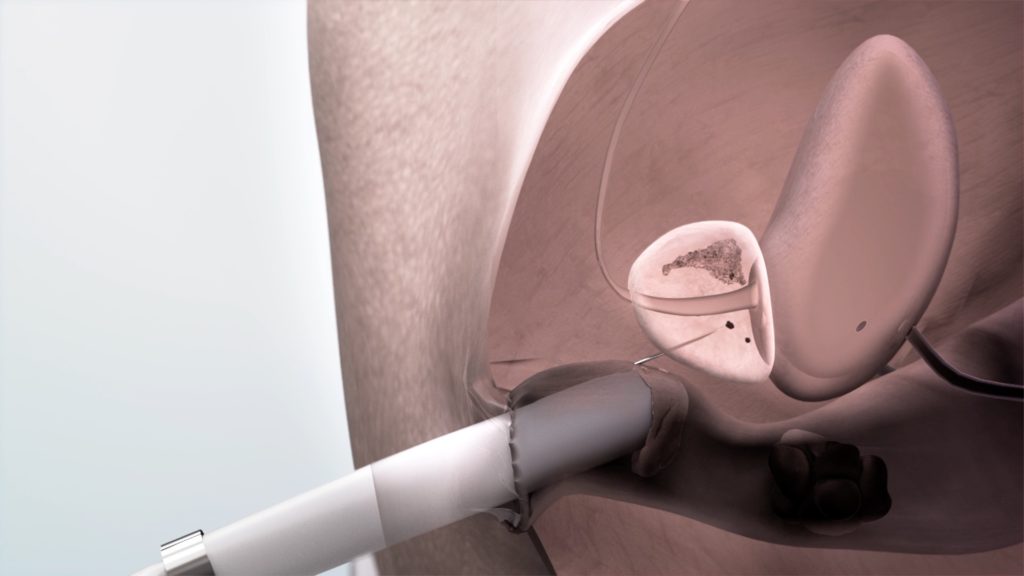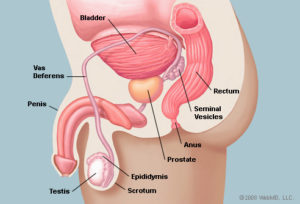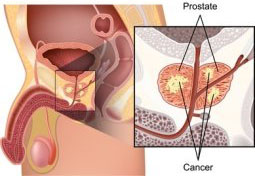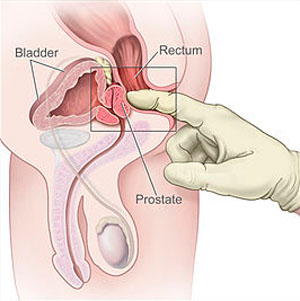Welcome! You are here because you want to learn more about the prostate and prostate cancer. The information below will provide you with a basic background to facilitate a conversation with your physician.
What Is The Prostate?
The prostate is a part of the male reproductive system, which includes the penis, prostate, and testicles. The prostate is about the size and shape of a walnut. It sits low in the pelvis, below the bladder and just in front of the rectum. The prostate helps make semen, the milky fluid that carries sperm from the testicles through the penis when a man ejaculates.
The prostate surrounds part of the urethra, a tube that carries urine out of the bladder and through the penis.
Because the prostate gland tends to grow larger with age, it may squeeze the urethra and cause problems in passing urine. Sometimes men in their 30s and 40s may begin to have these urinary symptoms and need medical attention. For others, symptoms aren’t noticed until much later in life. An infection or a tumor can also make the prostate larger.
Growing older raises your risk of prostate problems. The three most common prostate problems are:
– Inflammation (prostatitis)
– Enlarged prostate (BPH, or benign prostatic hyperplasia)
– Prostate cancer
One change does not lead to another. For example, having prostatitis or an enlarged prostate does not increase your risk of prostate cancer. It is also possible for you to have more than one condition at the same time.
Most prostate changes are not cancer.
For further reading…
What Is Prostate Cancer?
Cancer is a disease in which cells in the body grow out of control. When cancer starts in the prostate, it is called prostate cancer. Except for skin cancer, prostate cancer is the most common cancer in American men.
Different people can exhibit different symptoms for prostate cancer. Some men might exhibit no symptoms.
If you have any symptoms that worry you, be sure to see your doctor right away. Keep in mind that these symptoms may be caused by conditions other than prostate cancer. (from CDC.gov)
For further reading…
How Is Prostate Cancer Diagnosed?
Men who report prostate symptoms often undergo a couple of simple tests to help doctors determine the nature of the problem.
The digital rectal exam (DRE) is a relatively simple test to check the prostate. Because the prostate is an internal organ, your doctor cannot look at it directly. But because the prostate lies in front of the rectum, he or she can feel it by inserting a gloved, lubricated finger into the rectum.
Prostate-specific antigen (PSA) is a protein produced by cells of the prostate gland. The PSA test measures the level of PSA in a man’s blood. For this test, a blood sample is sent to a laboratory for analysis. The results are usually reported as nanograms of PSA per milliliter (ng/mL) of blood.
If your prostate specific antigen (PSA) test or digital rectal exam (DRE) is abnormal, doctors may do more tests to find or diagnose prostate cancer.
A PROSTATE BIOPSY is often the next step…
Prostate Biopsy: TRANSRECTAL vs. TRANSPERINEAL
Each year nearly one million prostate biopsies are performed. There are two physical pathways to access the prostate for tissue samples- 1. via the rectum (TRANSRECTAL) or 2. via the perineum, the area between the anus and the scrotum (TRANSPERINEAL).
The Traditional Method of Prostate Biopsy (TRANSRECTAL)
 For over 30 years the transrectal path has been the standard method to biopsy the prostate.
For over 30 years the transrectal path has been the standard method to biopsy the prostate.
Because this technique obtains prostate tissue samples through the rectal wall it is possible to introduce fecal material and bacteria into the prostate.
Due to increased rates of antibiotic-resistant bacteria the risk of infection after the prostate biopsy has risen dramatically. Over the past 10 years the risk of infection has approached 6% and the risk of hospitalization due to sepsis has reached 3%.
An additional drawback of this approach is the relative difficulty in accessing certain zones of the prostate where cancer is sometimes found.
Infectious complications and false negative results are of paramount concern with the TRANSRECTAL method.
Now there is a better way…
The Better, Safer Method of Prostate Biopsy (TRANSPERINEAL using The PrecisionPoint®)
By passing the biopsy needle through the perineum instead of the rectum, the risks associated with the transrectal approach are avoided.
Using the TRANSPERINEAL method in a freehanded, constant ultrasound-supervised technique allows the surgeon to maintain accurate sampling of all zones of the prostate while at the same time avoiding the coliform bacteria responsible for infections.
The TRANSPERINEAL method offers the distinct advantages of minimizing, or even eliminating, the risk of infection while maximizing the cancer detection rate.
The PrecisionPoint® Transperineal Access System is facilitating the transition to the TRANSPERINEAL method.
“This approach requires no antibiotics at all, and the international reports indicate virtually no infectious complications – it is likely to become the main approach in prostate biopsies in the next few years.”
“This approach requires no antibiotics at all, and the international reports indicate virtually no infectious complications – it is likely to become the main approach in prostate biopsies in the next few years.”






 Prostate cancer is cancer that occurs in a man’s prostate — a small walnut-shaped gland that produces the seminal fluid that nourishes and transports sperm.
Prostate cancer is cancer that occurs in a man’s prostate — a small walnut-shaped gland that produces the seminal fluid that nourishes and transports sperm.

